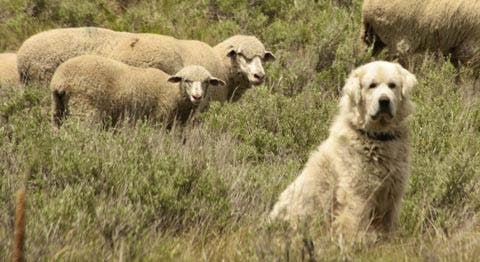Defenders expands its coexistence project in the Rockies

For nearly a decade, Mike Stevens has been running sheep through the Sawtooth Mountains of central Idaho. As a managing member and past president of Lava Lake Lamb, Stevens’ goal is to fatten lambs and ewes on the forbs, grasses and wildflowers that grow there during lush summer months. But he’s also responsible for making sure that his free-ranging livestock operation is compatible with conserving wildlife, especially gray wolves.
“Lava Lake is one of the best examples we have of how ranchers can help limit conflict with wolves, and Mike has been a terrific ambassador,” says Suzanne Stone, Defenders’ Northern Rockies representative. Her voice carries softly over the gurgling of Eagle Creek, interrupted occasionally by the bleats of some 2,200 sheep tucked into a sagebrush meadow behind her. More than 20 scientists from around the world gathered here in June to learn more from Stone and Stevens about the Wood River Wolf Project.
Since 2008, Defenders’ signature wolf coexistence project has helped sheep producers like Lava Lake take proactive steps to protect their flocks from wolves and other native wildlife. Over the last four years, wolves killed fewer than two dozen sheep in an area where more than 10,000 sheep pass through each summer. By helping herders deploy nonlethal deterrents, such as guard dogs and brightly colored flags known as fladry, project partners have been able to keep livestock losses to a minimum.
“It’s pretty amazing what we’ve been able to accomplish with just a few simple tools,” says Stone. “A few guard dogs, a line of fladry and a vigilant herder are usually all it takes to keep both sheep and wolves alive and out of trouble.”
Now Stone is hoping to expand the project’s reach. In previous years, Defenders hired a team of field technicians to spend the summer months following bands of sheep, which meant spending days at a time hiking over steep terrain in remote and forested backcountry. They would monitor wolf activity using radio telemetry, help the herders set up fladry, and frequently sleep beside bands of sheep, waking every hour to shine bright lights, fire a starter pistol or sound an air horn to keep wolves away.
The model is proving highly effective. But field techs cover just so much ground and can only keep an eye on one flock at a time. To cover the entire county—let alone other areas across the Northern Rockies—will take the cooperation of landowners and state and federal wildlife agencies.
“We don’t have the funding to hire a field technician for every rancher that wants our help,” says Stone. “To reach more people in more areas, we need our entire crew available on a daily basis, not camped out in the wilderness for days on end.”
Instead, the Wood River team is now offering free consultations to any ranchers in the county looking for advice on how to use the livestock-protecting deterrents. Defenders has also set up a dedicated hotline for ranchers who want immediate assistance if they suspect wolves are nearby and is offering training for state and federal wildlife managers.
Once they arrive on the scene, technicians conduct a thorough site analysis to assess potential risks to livestock, then they recommend the best nonlethal tool for preventing conflict. Recommendations are tailored to the type of livestock operation, the topography of the surrounding landscape, and the tools already available to the rancher.
“Every situation is unique, so we try to customize our solutions to each rancher’s specific needs,” says Stone. For example, existing fencing can be used to hang electrified “turbo-fladry” quickly and effectively, pregnant ewes can be brought inside to give birth to their lambs, and livestock guarding dogs can be deployed to help watch at night when sheep are most vulnerable to attack.
With fewer conflicts, ranchers are becoming more tolerant of wolves and may allow more packs to continue to thrive in areas where grazing occurs.
“We’re trying to engage as many ranchers as we can,” says Stone. “Ultimately, the fate of wolves may rest in their hands. Safeguarding livestock means more wolves can survive on the landscape.”
—John Motsinger
Only select articles from Defenders are available online. To receive 4 issues annually of the full award-winning magazine, become a member of Defenders of Wildlife!


